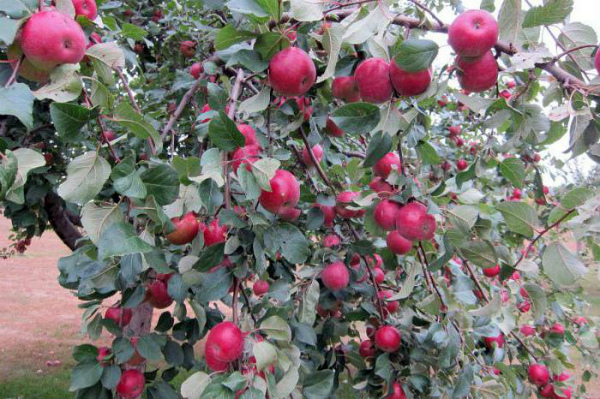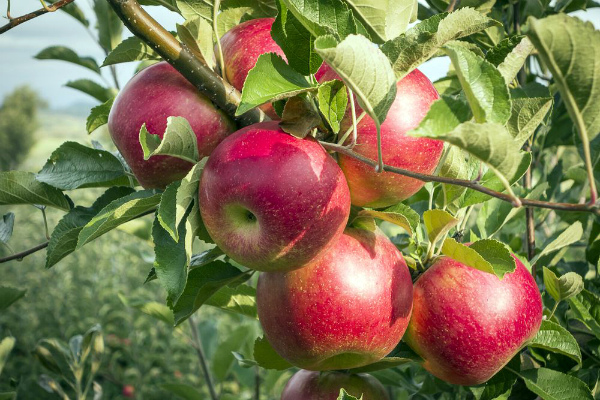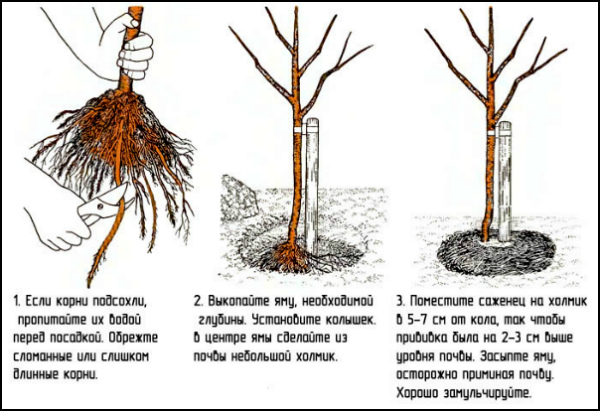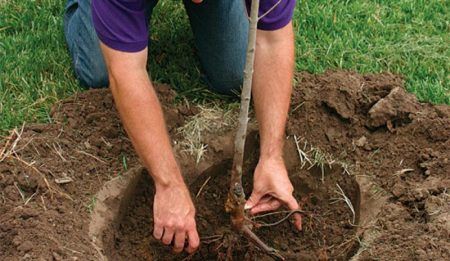Apple tree Silver hoof - excellent summer variety
Content
Pollination
Silver Hoof is one of the self-fertile varieties, so trees will need pollinating neighbors. Through trial and error, gardeners found out that the Anis Sverdlovsky variety is the best pollinator. However, you can choose a pollinator yourself, the main thing is that the variety blooms and bears fruit at the same time as the Silver Hoof. The maximum distance between apple trees should not exceed 1 kilometer.
Apple tree appearance
The description of the apple tree should begin with the fact that the tree grows of medium height, while it has a compact, rounded crown. This allows you to plant apple trees quite close to each other. Skeletal branches are covered with light yellow bark, located almost at right angles to the trunk. The arrangement of the branches is predominantly straight, while being extremely compact. Fruiting takes place on ringlets, fruit spears and last year's growths.
The shoots of the Silver Hoof trees are not very thick, straight, very pubescent and dark brown with a reddish tint. The crown is filled with light green leaves with a matte sheen. They are rounded in shape with raised, double-crenate, serrated edges. Flower buds are rounded, wide-cupped. The buds bloom into medium-sized white cupped flowers. The petals are semi-closed, the stigmas of the pistils rise somewhat above the anthers.
The apples of this variety are small, rarely medium in size, weighing no more than 90 grams. They are round, smooth, ribbing is almost not pronounced. The peel is tender, dry with a pronounced waxy coating, the subcutaneous points are almost invisible. The main color of apples is deep cream, but almost the entire surface is a blurred orange-red blush. The peduncle is short, not very thick. Funnel of acute conical shape, gray-green color. The core is small, resembling a turnip in shape, the seed chambers are open, small, filled with dark brown seeds.
The "Silver Hoof" ripens in mid-August, and the marketable quality of the fruit can be preserved until the end of October. If apples are left on the branches before early September, they become translucent.
The pulp has a rich sweet and sour taste, light, dense with a fine-grained structure, extremely juicy, but does not have a pronounced aroma. For 100 grams of apple pulp, there are:
- 13% dry matter;
- 11% sugar;
- 0.8% titrated acids;
- 13 mg ascorbic acid;
- 112 mg of P-active substances.
Apples of this variety tolerate transportation well.
Breeding history
For the first time, the Silver Hoof variety was bred in 1988 after crossing the Rainbow and Snezhinka varieties. The development and improvement of the variety was carried out by the scientist-breeder L.A. Kotov at the Sverdlovsk experimental gardening station.
"Silver Hoof" is intended for cultivation in the Sverdlovsk, Chelyabinsk, Kurgan and Kirov regions, as well as Kazakhstan.However, the apple tree grows best of all in the West Siberian region.
Yield
Silver Hoof is a moderately early-growing variety, the first harvest can be obtained from four-year-old trees. However, it will not have all of the above characteristics. In full force, apple trees bear fruit in the fifth or sixth year. At the same time, its stable yield can be considered an undoubted advantage of the variety. This means that every year you will receive the same number of apples from each tree, except for those cases when agricultural practices are violated during cultivation - this leads to a decrease in the size of apples in particular and the yield in general.
Planting and leaving
Planting of the "Silver Hoof" variety is carried out both in spring and in autumn. However, based on the experience of most gardeners, it is definitely recommended to plant apple trees in the fall. You will need a well-lit place, the groundwater level should be as deep as possible so as not to harm the root system of trees. It is desirable that the site has light, loose soil that will not impede the access of oxygen to the roots.
For planting, you will need a hole 60-70 centimeters deep, wide enough to accommodate a seedling with straightened roots without any problems. The pit is filled with a mixture of humus (4 kilograms), superphosphate (40 grams), potassium (20 grams) and urea (20 grams). In order not to burn the roots, sprinkle the fertilizer with clean soil, forming a small mound, on which you place the seedling. Attach it to the support peg and start filling the hole with earth. At the end of the procedure, water the seedling abundantly, pouring water until it is absorbed.
Taking care of the Silver Hoof is easy. In the second year of the tree's life, it is necessary to form a crown, cutting off about a third of the length of the shoots. In the first four years of growing an apple tree in your garden, it is necessary to break off all ovaries so that the tree concentrates on growth, not fruiting. This will help improve the quality and quantity of the crop. In subsequent years, it is recommended to remove the central ovary in the inflorescence.
In addition, the tree needs regular loosening of the soil in the near-trunk circle, as well as stable watering and top dressing. Apple trees are watered several times a month. Also, it will not be possible to do without preventive treatments with fungicides and insecticides to protect trees from pests. Spraying is carried out twice a year: when the buds are just swelling and before flowering begins.
Disease and pest control
The Silver Hoof variety is moderately resistant to diseases caused by fungal microorganisms. Most often, trees are affected by scab and fruit rot.
In case of damage by fruit rot, cracks and small ulcers appear on the apples, which turn into foci of rot. Gradually, the apple rots completely. When a scab is hit, the leaves are hit, and then the fruits.
The main reason for the development of fungal diseases is excessive thickening of the crown and, as a result, insufficient ventilation.
In order to avoid contamination of trees, it is necessary to immediately remove the infected parts of the tree, and regularly carry out treatment with complex fungicides.
As a preventive control against the codling moth, leafworm, red aphids and spider mites, it is recommended to treat trees and the soil around them with preparations based on karbofos, as well as use corrugated paper traps.
Video "Planting an apple tree"
This video demonstrates the process of choosing an apple seedling and planting it in a summer cottage.






